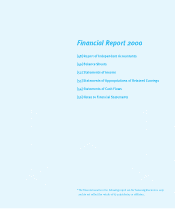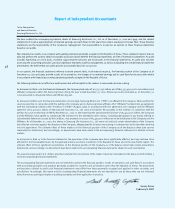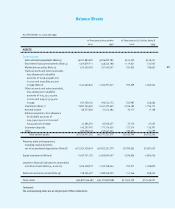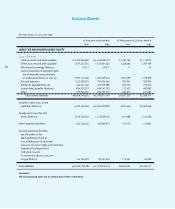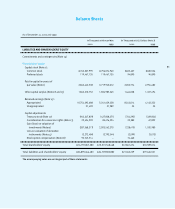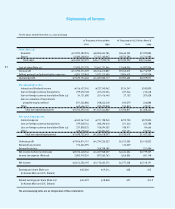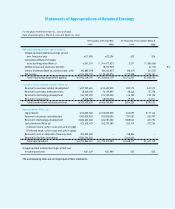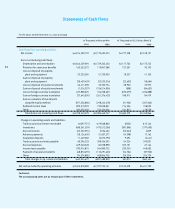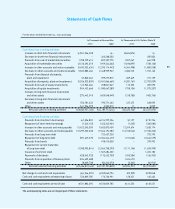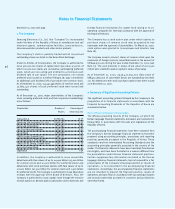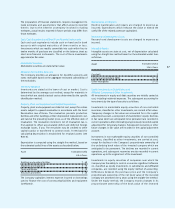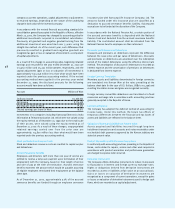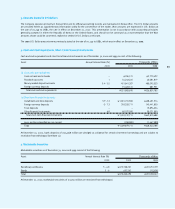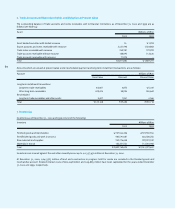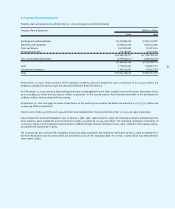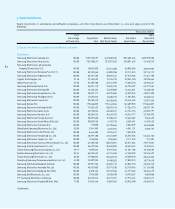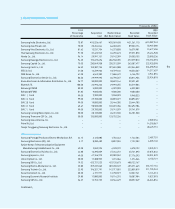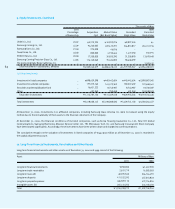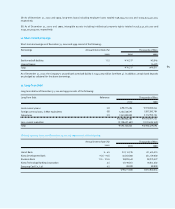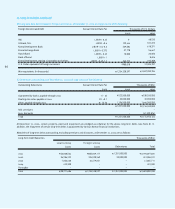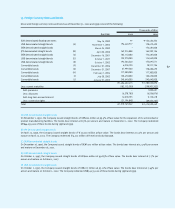Samsung 2000 Annual Report Download - page 57
Download and view the complete annual report
Please find page 57 of the 2000 Samsung annual report below. You can navigate through the pages in the report by either clicking on the pages listed below, or by using the keyword search tool below to find specific information within the annual report.
The preparation of financial statements requires management to
make estimates and assumptions that affect amounts reported
therein. Due to the inherent uncertainty involved in making
estimates, actual results reported in future periods may differ from
those estimates.
Cash, Cash Equivalents and Short-Term Financial Instruments
Cash and cash equivalents include cash on hand and in bank
accounts with original maturities of three months or less.
Investments which are readily convertible into cash within four to
twelve months of purchase are classified on the balance sheet as
short-term financial instruments. The cost of these investments
approximates fair value.
Marketable Securities
Marketable securities are stated at fair value.
Allowance for Doubtful Accounts
The Company provides an allowance for doubtful accounts and
notes receivable based on the aggregate estimated collectibility of
the receivables.
Inventory Valuation
Inventories are stated at the lower of cost or market. Cost is
determined by the average cost method, except for materials in
transit which are stated at actual cost as determined by the specific
identification method.
Property, Plant and Equipment and Related Depreciation
Property, plant and equipment are stated at cost, except for certain
assets subject to upward revaluation in accordance with the Asset
Revaluation Law of Korea. The revaluation presents production
facilities and other buildings at their depreciated replacement cost,
and land at the prevailing market price, as of the effective date of
revaluation. The revaluation increment, net of revaluation tax, is
first applied to offset accumulated deficit and deferred foreign
exchange losses, if any. The remainder may be credited to other
capital surplus or transferred to common stock. A new basis for
calculating depreciation is established for revalued assets (see
Note 8).
Depreciation is computed using the straight-line method, based on
the estimated useful lives of the assets as described below.
The Company capitalizes interest expense incurred on borrowings
used to finance the cost of constructing facilities and equipment
(see Note 8).
Maintenance and Repairs
Routine maintenance and repairs are charged to expense as
incurred. Expenditures which enhance the value or extend the
useful life of the related assets are capitalized.
Research and Development Costs
Research and development costs are charged to expense as
incurred.
Intangible Assets
Intangible assets are state at cost, net of depreciation calculated
using the straight-line method based on the estimated useful lives
as follows:
Equity Investments in Subsidiaries and
Affiliated Companies & Other Investments
All investments in equity and debt securities are initially carried at
cost, including incidental expenses. The subsequent accounting for
investments by the type of security is as follows.
Investments in marketable equity securities of non-controlled
investees, classified as other investments, are carried at fair value.
Temporary changes in fair value are accounted for in the capital
adjustment account, a component of shareholders’ equity. Declines
in fair value which are anticipated to be permanent are recorded in
current operations after eliminating any previously recorded capital
adjustment for temporary changes. Subsequent recoveries or other
future changes in fair value are recorded in the capital adjustment
account.
Investments in non-marketable equity securities of non-controlled
investees, classified as other investments, are carried at cost,
except for declines in the Company’s proportionate ownership of
the underlying book value of the invested company which are
anticipated to be permanent. The declines are recorded in current
operations, and subsequent recoveries are also recorded in current
operations up to the original cost of the investment.
Investments in equity securities of companies over which the
Company has the ability to control or exercise significant influence
on, classified as equity investments in subsidiaries and affiliated
companies, are recorded using the equity method of accounting.
Differences between the purchase price and the Company’s
proportionate ownership of the net book value of the invested
company are amortized over 5 years using the straight-line method.
Under the equity method, the Company records changes in its
proportionate ownership of the book value of the invested
57
Asset
Goodwill
Intellectual proprietary rights
Other intangibles
Estimated Useful
Life in Years
5
5 - 10
2 - 25
Asset
Buildings and auxiliary facilities
Machinery and equipment
Tools and fixtures
Structures and others
Estimated Useful
Life in Years
7 - 60
2 - 10
2 - 10
2 - 40


